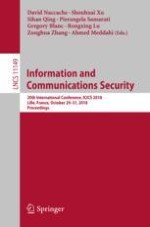2018 | OriginalPaper | Buchkapitel
Towards Practical Lattice-Based One-Time Linkable Ring Signatures
verfasst von : Carsten Baum, Huang Lin, Sabine Oechsner
Erschienen in: Information and Communications Security
Aktivieren Sie unsere intelligente Suche, um passende Fachinhalte oder Patente zu finden.
Wählen Sie Textabschnitte aus um mit Künstlicher Intelligenz passenden Patente zu finden. powered by
Markieren Sie Textabschnitte, um KI-gestützt weitere passende Inhalte zu finden. powered by
